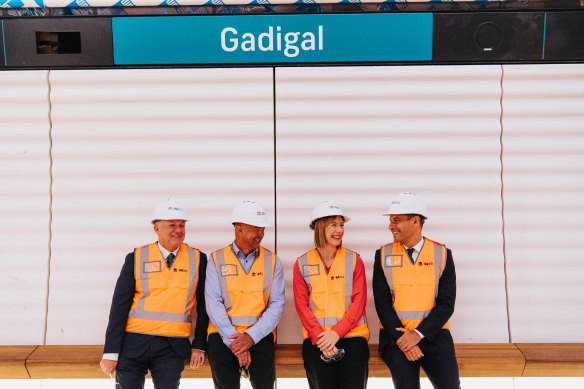This was published 1 year ago
Giant holes beneath Sydney reshaped into train station with new name
From the outside, the site for a $500 million metro train station under the heart of central Sydney resembles any of the high-rise developments dotting the city.
Yet behind the temporary hoardings near Town Hall, two large entrances – featuring giant murals that nod to railways of the past – open up to sets of escalators, walkways and underground platforms.
It will now also recognise the local Indigenous people, after the NSW government confirmed that the station under Pitt, Park and Bathurst streets will officially be named Gadigal, ending a dispute over what to call the stop.
Once giant holes and tunnels filled with construction equipment, the site has been transformed over the last four years into a state-of-the-art station. Thousands of commuters will pass through it each day when the main section of the $21.6 billion Metro City and Southwest opens next year.
Gadigal station will be crucial to relieving pressure on nearby Town Hall, which is the busiest interchange on Sydney’s rail network and a key pinch point.
The new metro stop – previously referred to as Pitt Street station – is less than 150 metres from both Town Hall station and a light rail stop, allowing commuters to switch between transport links.
Sydney Metro City and Southwest project director Hugh Lawson said Gadigal and two other new stations in the CBD, along with underground metro platforms at Central Station, would act like a “series of pairs” to the existing stations such as Town Hall and Martin Place. “It will really help take pressure off the Sydney Trains network in the city,” he said.
Unlike at Martin Place, Gadigal will not be linked to Town Hall by an underground walkway, because transport planners wanted to avoid creating a megastation there.
“The stations are deliberately kept a bit separate. If either station has a problem, they are not linked,” Lawson said. “One of the advantages of the metro network is its ability to absorb a lot of customers, particularly in disruptions.”
With Gadigal’s platforms about 17 metres below city streets, it is the shallowest underground station on the new line which extends from Chatswood in the north, under Sydney Harbour and the CBD, and onto Sydenham and Bankstown in the west. The five other new stations on the main section are between 25 metres and 30 metres below the surface.

Aboriginal Affairs Minister David Harris, left, Transport for NSW director of Aboriginal engagement George Shearer, Transport Minister Jo Haylen and MP for Sydney Alex Greenwich try out a wooden bench on one of the platforms.Credit: James Brickwood
About 9000 people are forecast to pass through Gadigal’s gates during the morning peak between 6.30am and 10am on weekdays, while almost 13,500 commuters are projected to enter and exit the new Martin Place station. At Town Hall station, about 38,000 tap-ons and tap-offs are recorded during the morning peak.
“[Gadigal] is going to be one of the target stations in the CBD that a lot of people are ultimately looking to end up at,” Lawson said.
Transport Minister Jo Haylen said the Geographic Name Board ran a process to name the station and many stakeholders including the Metropolitan Local Aboriginal Land Council believed it was the right name for this station.
“I think Sydneysiders will also agree that recognising Indigenous culture and heritage in the middle of our city is the right thing to do,” she said. “Next year Sydneysiders will enjoy what is a transformational public transport service.”
Plans to name the station Gadigal were thrown into doubt early last year when the then-transport and veterans’ affairs minister David Elliott proposed an alternative, suggesting it honour Captain Reginald Saunders, the first Indigenous Australian to be commissioned as an army officer.
The City of Sydney’s first Aboriginal councillor Yvonne Weldon said Gadigal country was ground zero in the devastation wrought by colonial incursion, and the station’s name was a small way to honour Sydney’s first people.
“Recognition and representation in the public domain is an important form of truth-telling,” she said.
The installation of signage, benches, seating, public address systems and passenger screens is nearing completion as part of the final work.
Giant murals called The Underneath by Melbourne-based artist Callum Morton adorn walls in the cavernous north and south entrances. “They’re very vibrant, but they’re trying to reflect the railway, the tunnels, and also the Tank Stream that ran across this site,” Lawson said.
A 39-storey office tower is under construction above the station’s northern entrance on Park Street, while a 39-storey apartment building is being erected above the southern entrance, near the historic Edinburgh Castle Hotel on the corner of Pitt and Bathurst streets.
The Metro City and Southwest rail project has been dogged by cost blowouts and challenges converting the 128-year-old line between Sydenham and Bankstown into one capable of carrying driverless trains. The government estimates the conversion will cost an extra $1 billion, pushing up the bill for the entire project to $21.6 billion – almost double the price tag last decade.
The main section of Metro City and Southwest has to open before a 13-kilometre stretch of the Bankstown line can be closed to commuters from the third quarter of next year to allow workers to complete the conversion of the track to metro train standards.
The Morning Edition newsletter is our guide to the day’s most important and interesting stories, analysis and insights. Sign up here.